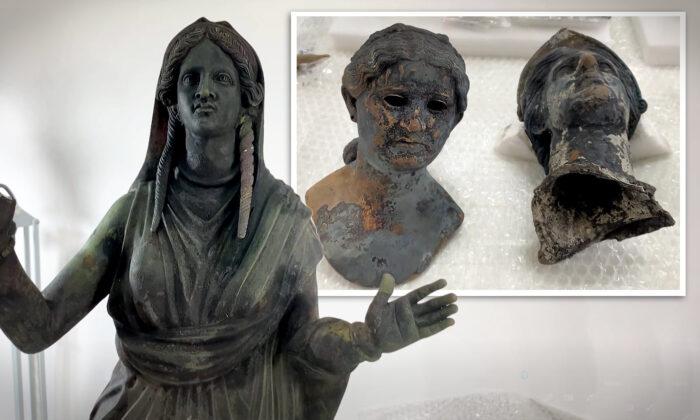Archaeologists in Italy have uncovered more than two dozen beautifully preserved bronze statues dating back to ancient Roman times in thermal baths in Tuscany, in what experts are hailing as a sensational find.
“From the bottom of the pool at the lowest point of its monumental construction, 24 masterpieces of bronze statues between the 2nd and 1st centuries B.C. have re-emerged,” Jacopo Tabolli, an assistant professor from the University for Foreigners in Siena, who coordinated the dig, told Reuters on Tuesday, Nov. 8.
“It was in the sacred pool that Etruscans and Romans made votive offerings together. These statues bear inscriptions dedicated to the god of the spring both in Latin and Etruscan,” he said.
“They are masterpieces of antiquity that add to and open a new chapter in the history of choreography and the sacred between the Etruscans and Romans.”



The statues were discovered in San Casciano dei Bagni, a hilltop town in Siena province, about 100 miles (160 kilometers) north of Rome, where archaeologists have been exploring the ruins of an ancient bathhouse since 2019.
“It is a very significant, exceptional finding,” said Tabolli.
Massimo Osanna, a top culture ministry official, called it one of the most remarkable discoveries “in the history of the ancient Mediterranean” and the most important since the Riace Bronzes, a giant pair of ancient Greek warriors, were pulled from the sea off the toe of Italy’s “boot” in 1972.

Tabolli said the statues, depicting Hygieia, Apollo, and other Greco-Roman divinities, used to adorn a sanctuary before they were immersed in thermal waters, in a sort of ritual, “probably around the 1st century A.D.”
A Time of Conflict
Most of the statues date to between the 2nd century B.C. and the 1st century A.D., a period of “great transformation in ancient Tuscany” as it switched from Etruscan to Roman rule, the culture ministry said in a statement.It was an “era of great conflicts” and “cultural osmosis,” in which the great bath sanctuary of San Casciano represented a “unique multicultural and multilingual haven of peace, surrounded by political instability and war,” the ministry said.
The statues were covered by almost 6,000 bronze, silver, and gold coins, and San Casciano’s hot, muddy waters helped to preserve them “almost like as on the day they were immersed,” Tabolli said.

The archaeologist said his team had recovered 24 large statues, plus several smaller statuettes, and noted that it was unusual for them to be made out of bronze, rather than terracotta.
Tabolli said this suggested they came from what he called an elite settlement, where archaeologists also found “wonderful inscriptions in Etruscan and Latin,” mentioning the names of powerful local families, the ministry statement added.
According to Culture Minister Gennaro Sangiuliano, the “exceptional discovery ... confirms once again that Italy is a country of immense and unique treasures.”
The ministry said the statues have been taken to a restoration laboratory in nearby Grosseto, but will eventually be put on display in a new museum in San Casciano.






